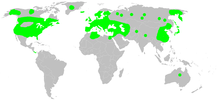Larinioides cornutus
| Larinioides cornutus | |
|---|---|

| |
| Scientific classification | |
| Domain: | Eukaryota |
| Kingdom: | Animalia |
| Phylum: | Arthropoda |
| Subphylum: | Chelicerata |
| Class: | Arachnida |
| Order: | Araneae |
| Infraorder: | Araneomorphae |
| Family: | Araneidae |
| Genus: | Larinioides |
| Species: | L. cornutus
|
| Binomial name | |
| Larinioides cornutus | |

| |
| Synonyms | |
| |

Larinioides cornutus, the furrow spider,
Physical description
Females reach a body length of about 6–14 mm, males up to 5–9 mm. Leg spans range from 18 to 35 mm.[1]
These spiders can be identified by their large, oval-shaped, bulbous abdomens. Colors can range from black, grey, and shades of red. The carapace on their abdomen almost always has a lighter shaded arrow pointing toward their cephalothorax, while the legs also have a similar arrow pattern.[3]
Their eye structure consists of a horizontal row of 6 eyes, with an additional pair above the center of the row. A common misconception is that spiders cannot hear, due to their lack of ears of other common structures. However, these animals do have the ability to sense sound due to macrosetate and filiform hairs on their legs.[4]
Habitat
These spiders are most often found in moist areas, especially near water. The web is built between grass or in low shrubbery. They hide during the day in a silken retreat that opens at the bottom, masked with plant and animal matter and leave it during the night. The web is remade in the evening.[5] Unlike many other species of animal and spider, the cornutus does not hibernate in winter, and instead has an annual cycle of seasonal resistance. While their supercooling point in summer is −8 °C, in winter it drops to −20 °C.[6]
Reproduction
Like mating in many other spiders, the females create a silk cocoon for copulation. The females reside in the cocoon, and emit pheromones to lure males, who can sense them through
The male lives with the female during mating time, which is in autumn and again in spring. The female produces three to five yellow egg sacs during the summer.[5]
There is possibly a distinct species L. folium, which is very similar but occurs in dry habitat.[5]
References
- ^ a b Weber, Larry (2003). Spiders of the North Woods. Duluth, MN: Kollath+Stensaas Publ. pp. 88–89.
- ^ Furrow Orb Weaver Spider – Larinioides cornutus, North American Insects & Spiders.
- ^ Gracely, John. "Larinioides cornutus". Animal Diversity Web. Retrieved 2020-12-01.
- S2CID 127309047.
- ^ a b c Bellmann, H. (1997). Kosmos-Atlas Spinnentiere Europas. Kosmos.
- ISBN 978-1-4008-8506-0, retrieved 2020-12-01
External links
 Media related to Larinioides cornutus at Wikimedia Commons
Media related to Larinioides cornutus at Wikimedia Commons
